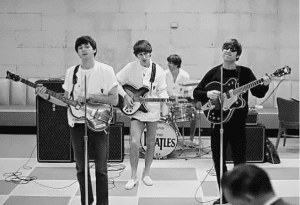10 Famous Musicians Who Hated Being In A Band

Metallica live in Europe, 2018 - LiveConcertsHD / Youtube
The music industry is full of contradictions. Some of the most iconic bands, the ones whose music continues to move us decades later, were also notorious for internal conflict. Was this fiery tension a secret ingredient in their creative process? Or a recipe for disaster?
While there’s no excuse for toxic behavior, it’s undeniable that bands like Fleetwood Mac and The Beatles managed to create groundbreaking music despite – or maybe even because of – their internal feuds. This raises a question: are these intense team dynamics necessary for musical success?
The answer, it seems, is complex. While some artists thrive on collaboration, others find true liberation in solo careers. But one thing remains constant: the music these bands produced is undeniable. They may have hated each other, but they sure knew how to make magic together. Let’s delve into the stories of 10 such musicians who achieved greatness despite – or maybe even fueled by – their band drama.
The Supremes
The Supremes started as a trio of friends: Florence Ballard, Mary Wilson, and Diana Ross. They found success in the early 1960s, taking turns on lead vocals and enjoying mentorship from Smokey Robinson. However, Motown founder Berry Gordy saw Ross as the star and began pushing her to the forefront.
This shift had devastating consequences. Ballard, sidelined as a backing singer, struggled with mental health issues and eventually left the group. Meanwhile, Ross, while favored by Gordy, felt ostracized by her bandmates. Torn between internal conflict and personal struggles, Ross too departed for a solo career.
The Supremes’ story highlights the dark side of manufactured pop success. Motown’s focus on mass appeal came at a cost, sacrificing the well-being of its talented artists.
The Smiths
The Smiths, despite their vastly different personalities, found incredible success together. Morrissey, the frontman, reveled in classic sounds and a rigid artistic approach. Johnny Marr, the guitarist, embraced musical exploration and pushing boundaries. While this contrast initially fueled their music, it eventually became a recipe for disaster.
Marr felt increasingly stifled by Morrissey’s vision. The singer’s fixation on 50s and 60s music clashed with Marr’s desire to experiment, exemplified by Morrissey’s refusal to cover Cilla Black, a decision that proved to be a “last straw” for the guitarist.
While creative differences can spark magic, in The Smiths’ case, they became an insurmountable obstacle. The friction between Morrissey and Marr ultimately led to the band’s break up, leaving behind a legacy of “what if” and a cautionary tale about the delicate balance needed within a band.
https://twitter.com/Gracro5/status/1743231506854666603
The Mamas and the Papas
The Mamas and the Papas were a band on borrowed time. Despite internal turmoil and a burning desire to disband, they were contractually obligated to create one final album. Michelle Phillips described those final days as “endless”, with each member desperate for an escape.
The irony? This dysfunctional group, riddled with arguments and personal clashes, produced some of the most iconic songs of their era. They even thrived in the shadow of Beatlemania, proving their musical talent transcended their tumultuous relationships.
The Mamas and the Papas’ story is a testament to the power of music to transcend personal differences. They may have hated being in a band together, but their music continues to resonate decades later.
The Smashing Pumpkins
The Smashing Pumpkins achieved massive success, but behind the scenes, the band battled internal friction. Billy Corgan, the frontman, is often viewed as a controlling and even hostile figure. When he attempted reunions, original members remained hesitant.
Originally, Corgan and James Iha co-wrote songs, with Iha’s guitar and D’arcy Wretzky’s bass creating their signature sound. However, Corgan became the sole songwriter and felt threatened by Wretzky’s relationship with Iha. This paranoia fueled his controlling behavior.
Corgan’s tactics backfired. According to Wretzky, he’d scapegoat band members, creating a tense atmosphere where everyone walked on eggshells. Wretzky ultimately left, citing Corgan’s “abusive” behavior. The band’s success may have come at a cost, leaving behind a legacy of fractured relationships.
The Everly Brothers
The Everly Brothers’ story began with smooth harmonies and brotherly love. However, their return from the Marines marked a turning point. Amphetamine use and constant arguments fractured their relationship beyond repair. Sibling rivalry is one thing, but the Everly brothers seemed deeply divided.
In 1973, the tension reached a boiling point. Don declared his fatigue with being an Everly Brother, prompting Phil to smash his guitar on stage. Years later, Don revealed that even their early days weren’t perfect. Clashing political views simmered beneath the surface throughout their career.
The guitar incident marked a symbolic end. Don performed solo the next night, stating the Everly Brothers had been dead for a decade. While their solo careers produced gems like “Werewolves of London”, a musical reunion remained elusive for many years.
Metallica
Metallica’s internal struggles are no secret. The 2004 documentary Some Kind of Monster laid bare the band’s creative clashes, personal demons, and the weight of fame. More than just arguments, the film reveals the deep-seated issues that threatened to tear Metallica apart.
Therapy sessions showcased the raw emotions fueling the discord. Each member battled personal challenges that impacted their ability to create together. James Hetfield’s struggles with alcoholism and rehab caused a major rift, jeopardizing the completion of their album St. Anger.
The immense personal, professional, and mental differences between the members became roadblocks throughout their careers. Some Kind of Monster serves as a stark reminder of the challenges even the most successful bands face in navigating the complexities of internal dynamics.
Van Halen
Van Halen’s internal conflicts were as legendary as their music. One major point of contention was David Lee Roth’s focus on image. He famously pushed for outrageous visuals, like a bondage-inspired photoshoot, which clashed with the band’s musical direction.
Eddie Van Halen, the band’s virtuoso guitarist, also had his share of friction with band members. He criticized bassist Michael Anthony’s skills, claiming to have taught him every note he played. This dismissive attitude likely contributed to tension within the band.
Sammy Hagar, another vocalist for Van Halen, wasn’t spared Eddie’s ire either. Hagar’s abrupt exit from the band was shrouded in confusion. He claims Eddie told him he “always wanted to be a solo artist” and planned to reunite with David Lee Roth. This incident highlights the fractured relationships that plagued Van Halen throughout their career.
Fleetwood Mac
Fleetwood Mac is a textbook example of dysfunctional band dynamics. Following the addition of Lindsey Buckingham and Stevie Nicks, the band’s sound shifted. Nicks brought a focus on ethereal vocals and poetic lyrics, while Buckingham offered a rock and roll edge, reviving the earlier Mac sound.
But beneath the surface simmered a sea of emotions. Each member wrestled with anger, frustration, heartbreak, and trauma. These conflicts fueled constant arguments and even walk-outs.
Ironically, this very discord became the band’s greatest muse. Rumours, a landmark album born from the ashes of these tumultuous relationships, is a testament to this phenomenon. Fleetwood Mac themselves have acknowledged the link between their internal struggles and their songwriting, proving that sometimes the greatest music comes from the most troubled places.
https://twitter.com/historyrock_/status/1782143589515997223
Oasis
The Gallagher brothers of Oasis were about as different as two rockstars could be. Noel, the mastermind, crafted the band’s sound and direction. Liam, the frontman, was known for his raw vocals and increasingly headline-grabbing antics. Their legendary feuds could fill a book, making an Oasis reunion a distant dream for fans.
Despite their personal animosity, Oasis achieved meteoric success. However, Liam’s frustration with the band’s evolution fueled a toxic dynamic. He resented the changing direction and acted out towards Noel, ultimately leading to the band’s demise.
Oasis’ legacy is a testament to the power of artistic creation amidst personal turmoil. Their music, some of the best of the British indie revival, proves that even the most dysfunctional bands can produce brilliance.
The Beatles
The Beatles’ public breakdown is often blamed on a feud between Paul McCartney and John Lennon. However, the cracks ran deeper. While their clash was certainly a factor, each member – McCartney, Lennon, George Harrison, and Ringo Starr – grappled with their own reasons for wanting to leave.
Focusing solely on McCartney and Lennon as the culprits overshadows the dissatisfaction felt by the other members. Ringo Starr and George Harrison, often seen as bystanders, expressed their own frustrations. Interviews reveal a growing sense of disharmony that affected everyone.
Harrison perfectly captured the band’s sentiment, sharing that there was a negative atmosphere that no one could shake. He ultimately left, declaring, “I just got so fed up with the bad vibes…I didn’t care if it was The Beatles. I was getting out.” The Beatles’ story isn’t just about a falling out between two bandmates; it’s about a collective desire to escape a situation that no longer brought them joy.











